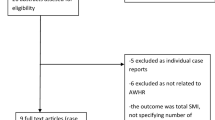Abstract
Aim
The aim of the study was to evaluate the frequency of superficial and prosthetic mesh infection following polypropylene mesh repair of different abdominal wall hernia in individual patients and to analyze the manifestation, clinical process and outcomes in patients with prosthetic mesh infection.
Methods
This was a retrospective analysis of 375 patients with 423 implanted meshes for groin, femoral, umbilical, incisional and epigastric hernias, with a mean follow-up of 15 months (range: 3–73 months).
Results
The total superficial infection rate was 1.65% percnt;, and the rate of mesh infection was 0.94% percnt;. There were no statistically significant differences in prosthetic mesh infection between monofilament and multifilament meshes as well as between the different repair groups of hernias. The deep incisional surgical site infection after previous operation was established as a significant risk factor for prosthetic mesh infection in incisional hernia repair (P < 0.0001). Five cases of prosthetic mesh infection were presented and analyzed.
Conclusions
There is no correlation between the superficial and prosthetic mesh infection. There may be difficulties in determining mesh infection and to choose the right tactic. The reconvalescence in all patients with mesh infection was achieved only after removal of the infected mesh.
Similar content being viewed by others
References
Managram AJ, Horan TC, Pearson ML, et al. Guideline for prevention of surgical site infection. Infect Control Hosp Epidemiol 1999;20:250–278
Rios A, Rodríguez JM, Munitiz V, et al. Antibiotic prophylaxis in incisional hernia repair using a prosthesis. Hernia 2001;5:148–152
Taylor EW, Duffy K, Lee K, et al. Surgical site infection after groin hernia repair. Br J Surg 2004;91:105–111
Aufenacker TJ, van Geldere D, van Mesdag T, et al. The role of antibiotic prophylaxis in prevention of wound infection after Lichtenstein open mesh repair of primary inguinal hernia. Ann Surg 2004;240:955–961
Kuzu MA, Hazinedaroğlu S, Dolalan S, et al. Prevention of surgical site infection after open prosthetic inguinal hernia repair: Efficacy of parenteral versus oral prophylaxis with amoxicillin-clavulanic acid in a randomized clinical trial. World J Surg 2005;29:794–799
Biswas S. Elective inguinal hernia repair with mesh: Is there a need for antibiotic prophylaxis? A review. World J Surg 2005;29:830–836
Aufenacker TJ, Koelemay MJ, Gouma DJ, et al. Systematic review and meta-analysis of the effectiveness of antibiotic prophylaxis in prevention of wound infection after mesh repair of abdominal wall hernia. Br J Surg 2006;93:5–10
Mann DV, Prout J, Havranek E, et al. Late-onset deep prosthetic infection following mesh repair of inguinal hernia. Am J Surg 1998;176:12–14
Taylor SG, O’Dwyer PJ. Chronic groin sepsis following tension-free inguinal hernioplasty. Br J Surg 1999;86:562–565
Stephenson B. Complications of open groin hernia repairs. Surg Clin North Am 2003;83:1255–1278
Falagas ME, Kasiakou SK. Mesh-related infections after hernia repair surgery. Clin Microbiol Infect 2005;11:3–8
Avtan L, Avci C, Bulut T, et al. Mesh infections after laparoscopic inguinal hernia repair. Surg Laparosc Endosc 1997;7:192–195
Foschi D, Corsi F, Cellerino P, et al. Late rejection of the mesh after laparoscopic hernia repair. Surg Endosc 1998;12:455–457
Hofbauer C, Andersen PV, Juul P, et al. Late mesh rejection as a complication to transabdominal preperitoneal laparoscopic hernia repair. Surg Enosc 1998;12:1164–1165
Ismail W, Agrawal A, Zia MI. Fate of chronic infected onlay mesh in groin wound. Hernia 2002;6:79–81
Amid PK, Shulman AG, Lichtenstein IL, et al. Biomaterials for abdominal wall hernia surgery and principles of their applications. Langenbecks Arch Surg 1994;379:168–171
Demiter S, Geçim IE, Aydinuraz K, et al. Affinity of Staphylococcus epidermidis to various prosthetic graft materials. J Surg Res 2001;99:70–74
Leber GE, Garb JL, Ajexander AI, et al. Long-term complications associated with prosthetic repair of incisional hernias. Arch Surg 1998;133:378–382
Morris-Stiff GJ, Hughes LE. The outcomes of nonabsorbable mesh placed within the abdominal cavity: literature review and clinical experience. J Am Coll Surg 1998;186:352–367
Costanza MJ, Heniford BT, Arca MJ, et al. Laparoscopic repair of recurrent ventral hernias. Am Surg 1998;64:1121–1127
Ramshaw BJ, Esartia P, Schwab J, et al. Comparison of laparoscopic and open ventral herniorrhaphy. Am Surg 1999;65:827–832
Heniford BT, Park A, Ramshaw BJ, et al. Laparoscopic ventral and incisional hernia repair in 407 patients. J Am Coll Surg 2000;190:645–650
Korenkov M, Paul A, Sauerland S, et al. Classification and surgical treatment of incisional hernia. Langenbecks Arch Surg 2001;386:65–73
Berger D, Bientzle M, Müller A. Postoperative complications after laparoscopic incisional hernia repair. Surg Endosc 2002;16:1720–1723
Post S, Weiss B, Willer M, et al. Randomized clinical trial of lightweight composite mesh for Lichtenstein inguinal hernia repair. Br J Surg 2004;91:44–48
Conze J, Kingsnorth AN, Flament JB, et al. Randomized clinical trial comparing lightweight composite mesh with polyester or polypropylene mesh for incisional hernia repair. Br J Surg 2005;92:1488–1493
Paajanen H. A single-surgeon randomized trial comparing three composite meshes (lightweight or heavyweight polypropylene and Vypro II® mesh) on chronic pain after Lichtenstein hernia repair in local anaesthesia. ISW 2005, Durban, South Africa, Abstract ID 2346
Deysine M. Pathophysiology, prevention and management of prosthetic infections in hernia surgery. Surg Clin North Am 1998;78:1105–1115
Matthews MR, Caruso DM, Tsujimura RB, et al. Ventral hernia synthetic mesh repair infected by Mycobacterium fortuitum. Am Surg 1999;65:1035–1037
Wantz GE, Chevrel JP, Flament JB, et al. Incisional hernia: the problem and the cure. J Am Coll Surg 1999;188:429–446
Petersen S, Henke G, Freitag M, et al. Deep prosthesis infection in incisional hernia repair: predictive factors and clinical outcome. Eur J Surg 2001;167:453–457
Favole AS, Chaparala RPC, Ambrose NS. Fate of the inguinal hernia following removal of infected prosthetic mesh. Hernia 2006;10:58–61
Stringer RA, Salameh JR. Mesh herniorrhaphy during elective colorectal surgery. Hernia 2005;9:26–28
Carbonell AM, Matthews BD, Dreau D, et al. The susceptibility of prosthetic biomaterials to infection. Surg Endosc 2005;19:430–435
Acknowledgements
This study was supported by the European Social Foundation.
Author information
Authors and Affiliations
Corresponding author
Additional information
An erratum to this article is available at http://dx.doi.org/10.1007/s00268-006-4001-x.
Rights and permissions
About this article
Cite this article
Jezupors, A., Mihelsons, M. The Analysis of Infection after Polypropylene Mesh Repair of Abdominal Wall Hernia. World J. Surg. 30, 2270–2278 (2006). https://doi.org/10.1007/s00268-006-0130-5
Published:
Issue Date:
DOI: https://doi.org/10.1007/s00268-006-0130-5



